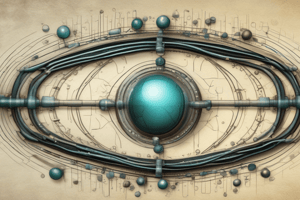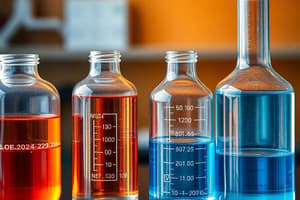Podcast
Questions and Answers
What type of ions are attracted to the anode?
What type of ions are attracted to the anode?
- Neutral molecules
- Cations
- Electrons
- Anions (correct)
What happens to the active anode electrode during electrolysis?
What happens to the active anode electrode during electrolysis?
- It becomes a cathode
- It produces oxygen
- It remains unchanged
- It gradually dissolves (correct)
What is the purpose of the universal indicator in the electrolysis of aqueous sodium sulfate?
What is the purpose of the universal indicator in the electrolysis of aqueous sodium sulfate?
- To identify the anode and cathode
- To catalyze the electrolysis reaction
- To measure the voltage of the battery
- To indicate the pH of the solution (correct)
What is the result of oxidation at the anode during the electrolysis of acidified water?
What is the result of oxidation at the anode during the electrolysis of acidified water?
What occurs at the anode during the electrolysis of Copper(II) sulphate solution using Copper Electrodes?
What occurs at the anode during the electrolysis of Copper(II) sulphate solution using Copper Electrodes?
What type of electrodes are used in the electrolysis of copper(II) sulfate?
What type of electrodes are used in the electrolysis of copper(II) sulfate?
What is the purpose of electroplating?
What is the purpose of electroplating?
What is the result of the electrolysis of impure copper using an impure copper anode and a pure copper cathode?
What is the result of the electrolysis of impure copper using an impure copper anode and a pure copper cathode?
What is the function of the dc power supply in electrolysis?
What is the function of the dc power supply in electrolysis?
What is the result of reduction at the cathode during electrolysis?
What is the result of reduction at the cathode during electrolysis?
What is the primary purpose of the electrochemical series?
What is the primary purpose of the electrochemical series?
Which of the following metals will displace iron from a solution of its salt?
Which of the following metals will displace iron from a solution of its salt?
What is the role of an electrolyte in electrolysis?
What is the role of an electrolyte in electrolysis?
What happens to magnesium when it is dipped into copper sulfate solution?
What happens to magnesium when it is dipped into copper sulfate solution?
What is the outcome of the reaction between magnesium and copper sulfate solution?
What is the outcome of the reaction between magnesium and copper sulfate solution?
Flashcards are hidden until you start studying
Study Notes
The Electrochemical Series
- The electrochemical series is a table that shows metals arranged in order of their tendency to lose electrons.
- The more readily a metal loses electrons, the more reactive it is.
- Potassium is at the top of the electrochemical series, and gold is at the bottom.
- A metal will displace another metal below it in the electrochemical series from a solution of its salt.
Displacement Reactions
- Magnesium ribbon dipped in copper sulfate solution displaces copper ions from the solution.
- The displaced copper then coats the magnesium ribbon.
- Zinc becomes covered in copper metal because zinc is higher in the electrochemical series and displaces copper.
Electrolysis
- Electrolysis is the breaking up of a substance due to an electric current passing through it in an aqueous solution or when molten.
- Electrolysis requires electrodes and an electrolyte.
- An electrolyte is a substance that conducts electricity when dissolved in water or when molten.
- Electrolytes themselves become chemically changed during electrolysis.
Electrodes
- An electrode is a conductor connected to the positive or negative end of a battery.
- There are two types of electrodes: inert electrodes (e.g., graphite and platinum) and active electrodes (e.g., copper).
- An active anode electrode gradually dissolves as electricity is passed through the electrolyte.
Anode and Cathode
- Oxidation occurs at the anode (OIL), and reduction occurs at the cathode (RIG).
- Anions are attracted to the anode, while cations are attracted to the cathode.
Experiment to Demonstrate Ionic Movement
- Copper dichromate solution breaks up into Cu²⁺ cations and Cr₂O₇²⁻ anions during electrolysis.
- Cu²⁺ cations are attracted to the cathode, and Cr₂O₇²⁻ anions are attracted to the anode.
Electrolysis of Aqueous Sodium Sulfate
- Sodium sulfate solution and universal indicator are used.
- At the anode, O₂ gas is released, and H⁺ ions are present.
- At the cathode, OH⁻ ions are released, causing the indicator to turn blue.
Electrolysis of Aqueous Potassium Iodide
- Potassium iodide solution and phenolphthalein indicator are used.
- At the anode, I₂ is formed, resulting in a brown color.
- At the cathode, K⁺ ions are reduced.
Electrolysis of Acidified Water
- This is carried out using a Hoffman Voltameter.
- Water breaks up into H⁺ and OH⁻ ions.
- H⁺ ions are reduced at the cathode, resulting in H₂ gas.
- OH⁻ ions are oxidized at the anode, resulting in O₂ gas.
Electrolysis of Copper (II) Sulfate Solution
- Copper electrodes are used.
- At the anode, copper is oxidized, and Cu²⁺ ions are released into solution.
- At the cathode, Cu²⁺ ions are reduced, and solid copper is formed.
Electroplating
- This involves coating one inexpensive metal with another more expensive metal using electrolysis.
- Examples include coating nickel cutlery with silver and chrome plating of steel.
Studying That Suits You
Use AI to generate personalized quizzes and flashcards to suit your learning preferences.




